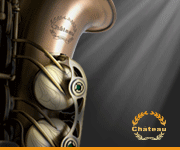 Forgot Username? Forgot Password?
Forgot Username? Forgot Password?
 SELMER St. Louis Gold Medal Model (1910-1921)
SELMER St. Louis Gold Medal Model (1910-1921)
After being recognized with a gold medal for clarinet design at the Saint Louis exhibition in 1904 and facing stiff competition from other important french manufactures such as Evette-Schaeffer, Buffet-Crampon, Couesnon and Noblet, Henri Selmer was emboldened to diversify and industrialize his instrument production. In addition to the entire family of clarinets, Selmer began to manufacture bassons, oboes, english horns, flutes, and yes, SAXOPHONES. This expansion was facilitated by opening a new workshop in Méru and a factory in Gaillon in 1912.
The St. Louis Gold Medal Model saxophone was the first saxophone actually designed by Selmer, although actually manufactured in the shop of Adolphe Sax Jr. at 84 Rue Myrha in Paris. The earliest record of this model saxophone is from a 1910 Selmer Paris catalog. Saxophones of this vintage are refered to as the gold medal model because they are all engraved or stamped "Medaille D'OR St. Louis 1904" in recognition of the St. Louis expo gold medal. These instruments were manufactured in Bb straight soprano, alto, tenor and baritone. C-melody was also added later in the production run.
Henri Lefevre was the chief architect behind the new design of this model. He and his father, Paul, started working for Selmer in 1905 after leaving Maison Robert (a Parisian clarinet manufacture). His brother Maurice started working for Selmer in 1910. The Lefevre's were master craftsmen and Henri had manufactured several instruments of his own making that bore his name. It was one of these Henri Lefevre saxophones that caught the eye of Henri Selmer. The design was radicallly different from the saxophones that Selmer was having stenciled by Edouard Adolphe Sax prior to 1910. For one, the Lefevre sax was keyed down to low Bb with both bell keys facing to the left (as you play the instrument). The other distinct advantage was a unique single key octave mechanism. Because Selmer was not tooled for saxophone production in 1910, this new model was again stenciled at the Adolphe Sax workshop. However, this time, it was done using Henri Lefevre's design and with his direct supervision. This arrangement forged an even closer relationship and intermingling between the factories of Henri Selmer and Adolphe Sax Jr. which culminated in 1928 when Selmer bought the Adolphe Sax factory, tooling, patterns, inventories and all rights to the name.
1910 also marked the return of Alexander Selmer (Henri's brother) to France from America where he had enjoyed a 15 year illustrious career as solo-clarinettist with three major Orchestras, the Boston Symphony Orchestra, the Cincinnati Symphony Orchestra and the New York Philharmonic Orchestra. His return was prompted by ever increasing demands being made for Selmer instruments. The US demand was almost entirely fueled by Alexander's reputation as a great player and by his establishing a retail storefront/repair shop in New York. When Alexander left, his star pubil, George Bundy, was left in charge of the Selmer New York store which he purchased from Alexander Selmer (thus the beginning of Selmer USA).
[less]After being recognized with a gold medal for clarinet design at the Saint Louis exhibition in 1904 and facing stiff competition from other important french manufactures such as Evette-Schaeffer, Buffet-Crampon, Couesnon and Noblet, Henri Selmer was emboldened to diversify and industrialize his in... [more]
Serial Numbers:
| Beginning Year | Beginning Number |
|---|---|
| 1910 | 250 |








